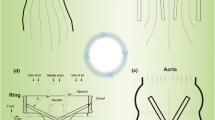Abstract
Employing arbitrary Lagrangian-Eulerian (ALE) finite element method, this paper studies the opening and closing process of a St. Jude medical valve through a two-dimensional model of the mechanical valve—blood interaction in which the valve is regarded as a rigid body rotating around a fixed point, and the blood is simplified as viscous incompressible Newtonian fluid. The numerical analysis of the opening and closing behaviour of as St. Jude valve suggested that: 1. The whole opening and closing process of an artificial mechanical valve is consisted of four phases: (1)Opening phase; (2) Opening maintenance phase; (3) Closing phase; (4) Closing maintenance phase. 2. The St. Jude medical valve closes with prominent regurgitat which results in water-hammer effect. 3. During the opening and closing process of the St. Jude valve, high shear stresses occur in the middle region of the two leaflets and on the valve ring. The present model has made a breakthrough on the coupling computational analysis considering the interactive movement of the valve and blood.
Similar content being viewed by others
References
B. J. Bellhouse, Velocity and pressure distributions in the aortic valve, J. Fluid Mech., 37 (1969), 587.
B. J. Bellhouse and L. Talbot, The fluid mechanics of the aortic valve, J. Fluid. Mech. 35 (1969), 721.
N. V. Gillani and W. M. Swanson, Time-dependent laminar incompressible flow through a spherical cavity, J. Fluid Mech., 78 (1976), 99.
J. L. Mercer, The movements of the dog's aortic valve studied by high-speed cineangiography, Brit. J. Radiol., 46 (1973), 344.
A. A.Van Steenhoven and M. E. H. Van Dongen, Model studies of the closing behaviour of the aortic valve, J. Fluid Mech., 90 (1979), 21–32.
C. S. F. Lee and L. Talbot, A fluid-mechanical study of the closure of heart valves, J. Fluid Mech., 91, 1 (1983), 41–63.
T. K. Hung, Hydrodynamic analysis of the aortic valve mechanics, Adv. Cardiovasc. Phys., 5, 1 (1983), 106–118.
W. M. Swanson and R. E. Clark, Aortic valve leaflet motion during systole, Circulation. Res., 32 (1973), 42–48.
M. Lei and Z. H. Kang, Study of the closing mechanism of natural heart valves, Appl. Math. and Mech. (English Ed.), 7, 10 (1986), 955–964.
S. X. Zhao and Z. X. Luo, The status of artificial heart valve, J. Biomed. Eng., 8, 3 (1991), 259–262. (in Chinese)
Swanson, et al., Flow and pressure measurement in accelerated fatigue testing of prosthetic heart valves, Proc. of Symp. at 14th Annul. Meeting of AAMT (1979).
T. Belytschko and D. P. Flanagan, Finite element methods with user-controlled meshes for fluid-structure interaction, Comput. Meths. Appl. Mech. Engrg., 33 (1982), 669–688.
W. K. Liu, T. Belytschko and H. Chang, An arbitrary Lagrangian-Eulerian finite element method for path-dependent materials, Comput. Meths. Appl. Mech. Engrg., 58 (1986), 227–245.
J. Donea, S. Giuliani and J. P. Halleux, An arbitrary Lagrangian-Eulerian finite element method for transient dynamic fluid-structure interactions, Comput, Meths. Appl. Mech. Engrg., 33 (1982), 689–723.
T. J. R. Hughes, W. K. Liu and T. K. Zimmermann, Lagrangian-Eulerian finite element formulation for incompressible viscous flows, Comput. Meths. Appl. Mech. Engrg., 29 (1981), 329–349.
B. Ramaswamy, Numerical simulation of unsteady viscous free surface flow, J. Comput. Physics, 90 (1990), 396–430.
D. K. Gartling and E. B. Becker, Finite element analysis of viscous, incompressible fluid flow, Part 1, Comput. Meths. Appl. Mech. Engrg., 8 (1976), 51–60.
D. K. Gartling and E. B. Becker, Finite element analysis of viscous, incompressible fluid flow, Part 2, Comput. Meths. Appl. Mech. Engrg., 8 (1976), 127–138.
W. K. Liu, H. Chang, J. S. Chen and T. Belytschko, Arbitrary Lagrangian-Eulerian Petrov-Galerkin finite elements for nonlinear continua, Comput. Meths. Appl. Mech. Engrg., 68 (1988), 259–310.
S. Q. Zou, Hemodynamics and Cardiovascular Artificial Organs, Publishing House of Chengdu University of Science and technology, Chengdu, Sichuan, China (1991).
C. Cuvelier, A. Segal and A. A. Van Steenhoven, Finite Element Methods and Navier-Stokes Equations, Reidel. Dordrecht, (1985).
F. N. Van Vosse, A. Segal, A finite element approximation of the unsteady two-dimensional Navier-Stokes equations, Int. J. Num. Meths. Fluid., 6 (1986), 427–443.
T. K. Hung and G. B. Schuessler, An analysis of the hemodynamics of the opening of the aortic valves, J. Biomechs., 10 (1977), 597–606.
S. R. Idelsohn, L. E. Costa and R. Ponso, A comparative computational study of blood flow through prosthetic heart valves using the finite element method, J. Biomech., 18, 2 (1985), 97–115.
A. A.Van Steenhoven, T. J. A. G. Duppen and J. W. G. Cauwenberg, In vitro closing behaviour of Bjork-Shiley, St. Jude and Hancock heart valve prostheses in relation to the vivo recorded aortic valve closure, J. Biomechs., 15, 11 (1982), 841–848.
K. B. Chandran, et al., Effect of prosthetic mitral valve geometry and orientation on flow dynamics in a model human left ventricle, J. Biomechs., 22, 1 (1989), 51–65.
Author information
Authors and Affiliations
Additional information
This research is supported by the National Natural Science Foundation and the Doctoral Foundation of China
Rights and permissions
About this article
Cite this article
Jianhai, Z., Dapeng, C. & Shengquan, Z. Ale finite element analysis of the opening and closing process of the artificial mechanical valve. Appl Math Mech 17, 403–412 (1996). https://doi.org/10.1007/BF00131088
Received:
Issue Date:
DOI: https://doi.org/10.1007/BF00131088




